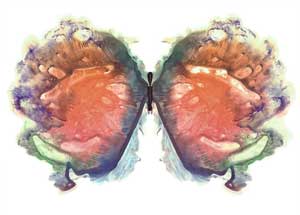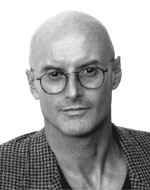Something very simple happens when you answer the question "Who are you?" When you are describing or explaining or even just inwardly feeling your "self", what you are actually doing, whether you know it or not, is drawing a mental line or boundary across the whole field of your experience, and everything on the inside of that boundary you are feeling or calling your "self", while everything outside that boundary you feel to be "not-self". Your self-identity, in other words, depends entirely on where you draw that boundary line.
You are a human and not a chair, and you know that because you consciously or unconsciously draw a boundary line between humans and chairs, and are able to recognize your identity with the former. You may be a very tall human instead of a short one, and so you draw a mental line between tallness and shortness, and thus identify yourself as 'tall". You come to feel that "I am this and not that" by drawing a boundary line between "this" and "that" and then recognizing your identity with "this" and your non-identity with "that".
So when you say "myself", you draw a boundary line between what is you and what is not you. When you answer the question "Who are you?" you simply describe what's on the inside of that line. The so-called identity crisis occurs when you can't decide how or where to draw the line. In short "Who are you?" means "Where do you draw the boundary?"
The most interesting thing about this boundary line is that it can and frequently does shift. It can be re-drawn. In a sense, the person can re-map his soul and find in it territories he never thought possible, attainable, or even desirable.
The most radical re-mapping or shifting of the boundary line occurs in experiences of the supreme identity, for here the person expands his self-identity boundary to include the entire universe. We might even say that he loses his boundary line altogether, for when he is identified with the "one harmonious whole" there is no longer any outside or inside and so nowhere to draw the line.
The most common boundary line that individuals draw up or accept as valid is the skin-boundary surrounding the total organism. This seems to be a universally accepted self/not-self boundary line. Everything on the inside of that skin boundary is in some sense "me" while everything outside that boundary is "not-me". Something outside the skin boundary may be "mine" but it is not "me". For example I recognize "my" car, "my" job or "my" house but they are definitely not directly "me" in the same way all the things inside my skin are "me". The skin-boundary then is one of the most fundamentally accepted self/not-self boundaries.
We might think that this skin-boundary is so obvious, so real, and so common that there wouldn't be any other types of boundaries really possible for an individual. But in fact there is another, extremely common, well-established type of boundary-line drawn by a vast number of individuals. For most people, while they recognize and accept as a matter of course the skin as a self/non-self boundary they draw another and, for them, more significant boundary within the total organism itself.
Let me ask "Do you feel you are a body or do you feel you have a body?" Most individuals feel that hey have a body as if they owned it or possessed it much as they would a car, a house or any other object. Under these circumstances the body seems not so much "me" as "mine" and what is "mine" by definition lies outside the self/not-self boundary. The part that the person identifies with more intimately is know variously as the mind, the psyche, the ego or the personality.
Biologically there is no the least foundation for this dissociation or radical split between the mind and the body, the psyche and the soma, the ego and the flesh, but psychologically it is an epidemic. Indeed the mind-body split and attendant dualism is a fundamental perspective of Western civilisation. Notice even here I must use the word "psych-ology" for the study of man's overall behaviour. The word itself reflects the prejudice that man is basically a mind and not a body. Even St Francis referred to his body as "poor brother ass" and most of us do indeed feel that we just sort of ride around on our bodies like we would on a donkey or an ass.
This boundary line between mind and body is certainly a strange one, not at all present at birth. But as an individual begins to grow in years, and begins to draw up and fortify his self/not-self boundary he looks upon the body with mixed emotions. She he directly include it within the boundary of his self, or is it to be viewed as foreign territory?
On the one hand the body is the source of much pleasure throughout life, from the ecstasies of erotic love to the subtleties of fine foods and mellowness of sunsets taken in by the body's senses. But on the other hand the body houses the spectre of crippling pain, debilitating diseases and the tortures of cancer. For a child the body is the only source of pleasure and yet it is the first source of pain and conflict with the parents. And on top of that the body seems to be manufacturing waste products that, for reasons totally mystifying to the child, are a constant source of alarm and anxiety for the parents. Bed-wetting, bowel movements, nose blowing – what an incredible fuss! And it's all tied up with this – the body. Where to draw the line is going to be tough.
But by the time the individual has matured he has generally kissed poor brother ass good-bye. As the self/not-self boundary is finalised, brother ass is definitely on the other side of the fence. The body becomes foreign territory, almost (but never quite) as foreign as the external world itself. The boundary is drawn between the mind and the body and the person identifies squarely with the former. He even comes to feel that he lives in his head as if he were a miniature man in his skull, giving directions and commands to his body, which may or may not obey.
 In short, what the individual feels to be his self-identity does not directly encompass the organism-as-a-whole, but only a facet of that organism, namely his ego. That is to say, he identifies with a more or less accurate mental self-image, along with the intellectual and emotional processes associated with that self-image. Since he won't concretely identify with the total organism, the most he will allow is a picture or image of the total organism. Thus he feels he is an "ego" and that his body just dangles along under him. So we see here another major type of boundary line, one which establishes the person's identity as being primarily with the ego, the self-image.
In short, what the individual feels to be his self-identity does not directly encompass the organism-as-a-whole, but only a facet of that organism, namely his ego. That is to say, he identifies with a more or less accurate mental self-image, along with the intellectual and emotional processes associated with that self-image. Since he won't concretely identify with the total organism, the most he will allow is a picture or image of the total organism. Thus he feels he is an "ego" and that his body just dangles along under him. So we see here another major type of boundary line, one which establishes the person's identity as being primarily with the ego, the self-image.
As we can see, this self/not-self boundary line can be quite a flexible item. So it won't surprise us to find that even within the ego or mind – I am using these terms very loosely at the moment – yet another type of boundary line can be erected. For various reasons the individual can even refuse to admit that some of the facets of his own psyche are his. In psychological jargon he alienates them, or represses them, or splits them off, or projects them. The point is that he narrows his self/non-self boundary to only certain pars of his egoistic tendencies. This narrowed self-image we will be calling the persona, and its meaning will become more obvious as we proceed.
But as the individual identifies with only facets of his psyche (the persona) the rest of his psyche is then actually felt to be "not-self", foreign territory, alien, scary. He re-maps his soul so as to deny and try to exclude from consciousness the unwanted aspects of himself (these unwanted aspects we call "shadow"). To a greater or lesser extent the person becomes "out of his mind". This, quite obviously is another major and general type of boundary line.
We are not trying to decide which of these types of self-maps is "right", "correct" or "true". We are simply noting, in an impartial fashion, that there are indeed several major types of the self/not-self boundary line. And since we are approaching this topic in a non-judgemental way we can at least mention one other type of boundary line that is today receiving much attention, namely the boundary associated with so-called transpersonal phenomena.
"Transpersonal" means that some sort of process is occurring in the individual that, in a sense, goes beyond the individual. The simplest instance of this is extra-sensory perception, or ESP. Parapsychologists recognise several forms of ESP: telepathy, clairvoyance, precognition, retrocognition. We might also include out-of-body experiences, experiences of a transpersonal self, peak experiences and so on.
What all of these events have in common is an expansion of the self/not-self boundary beyond the skin boundary of the organism. Although the transpersonal experiences are somewhat similar to unity consciousness, the two should not be confused. In unity consciousness the person's identity is with the All, with absolutely everything. In transpersonal experiences the person's identity doesn't quite expand to the Whole, but it does expand or at least extend beyond the skin-boundary. He's not identified with the All but neither is his identity confined solely to the organism.
The point of this discussion of self/not-self boundaries is that there are not just one but many levels of identity available to an individual. These levels of identity are not theoretical postulates but observable realities – you can verify them in and for yourself. As regards these different levels, it's almost as if that familiar yet ultimately mysterious phenomenon we call consciousness were a spectrum, a rainbow-like affair composed of numerous bands or levels of self-identity.
Notice that we have outlined five classes or levels of identity. There are certainly variations on these five major levels and the levels themselves can be extensively subdivided, but these five levels appear to be basic aspects of human consciousness.
Let us take these major levels of identity and arrange them in some sort of order. This spectrum-like arrangement is represented in Fig. 1, which shows the self/not-self boundary line and the major levels of identity we discussed. Each different level results from the different "places" people can and do draw this boundary. Notice that the bottom line starts to break up towards the bottom of the spectrum (Fig. 1) in the area we are calling the transpersonal, and that it disappears entirely at the level of unity consciousness, because at that ultimate level self and not-self become "one harmonious whole".
It's obvious that each successive level of the spectrum represents a type of narrowing or restricting of what the individual feels to be his "self", his true identity, his answer to the question "Who are you?" At the base of the spectrum the person feels that he is one with the universe, that his real self is not just his organism but all of creation.
At the next level of the spectrum the individual feels that he is not one with the All but rather one with just his total organism. His sense of identity has shifted and narrowed from the universe as a whole to a facet of the universe, namely his own organism.
At the next level his self-identity has narrowed once again, for now he identifies mainly with his mind or ego, which is only a facet of his total organism. And on the final level of the spectrum he can even narrow his identity to facets of his mind, alienating and repressing the shadow or unwanted aspects of his psyche. He identifies with only part of his psyche, a part we are calling the persona.
With each successive level of the spectrum there are more and more aspects of the universe which appear to be external to the person's "self". Thus at the level of the total organism the environment appears outside the self-boundary, foreign, external, not-self. But on the level of the persona, the individual's environment and his body and aspects of his own psyche appear external, foreign, not-self.
A person on the level of the total organism will find the potential enemy is his environment – for it appears foreign, external and therefore threatening to his life and well-being. But a person on the ego level finds that not only his environment but also his own body are foreign territory and thus the nature of his upsets and conflicts is dramatically different. He has shifted the boundary line of his self and therefore shifted the battle line of his conflicts and personal wars. And in this case his body has gone over to the enemy.
As an individual draws up the boundaries of his soul, he establishes at the same time the battles of his soul. Each level sees different processes of the universe as strangers to it. And since, as Freud once remarked, every stranger seems an enemy, every level is potentially engaged in different conflicts with different enemies. In psychological jargon, different "symptoms" originate from different levels.
Finding the right therapy for you
The fact that different levels of the spectrum possess different characteristics, symptoms and potentials, brings us to one of the most interesting points of this view. There is today an incredibly vast and growing interest in all sorts of schools and techniques dealing with various aspects of consciousness. People are flocking to psychotherapy, Jungian analysis, mysticism, Psychosynthesis, Zen, Transactional Analysis, Rolfing, Hinduism, Bioenergetics, psychoanalysis, yoga and Gestalt. What all these schools have in common is that , in one way or another, they are all trying to effect changes in a person's consciousness. But there the similarity ends.
An individual sincerely interested in increasing his self-knowledge is faced with such a bewildering variety of psychological and religious systems that he hardly knows where to begin, whom to believe. Even if he carefully studies all the major schools of psychology and religion he is apt to come out just as confused as when he went in, for these various schools, taken as a whole, definitely contradict one another.
 For example in Zen Buddhism one is told to forget, or transcend, or see through one's ego; but in psychoanalysis one is helped to strengthen, fortify and entrench one's ego. Which is right? This is a very real problem, for the interested layman as well as for the professional therapist. So may different and conflicting schools, all aimed at understanding the very same person. Or are they?
For example in Zen Buddhism one is told to forget, or transcend, or see through one's ego; but in psychoanalysis one is helped to strengthen, fortify and entrench one's ego. Which is right? This is a very real problem, for the interested layman as well as for the professional therapist. So may different and conflicting schools, all aimed at understanding the very same person. Or are they?
That is, are they all aimed at the same level of a person's consciousness? Or is it rather that these different approaches are actually approaches to different levels of a person's self? Could it be that these different approaches, far from being conflicting and contradictory, actually reflect the very real differences in the various levels of the spectrum of consciousness? And could it be that these different approaches are all more or less correct when working with their own major level?
If this is true it would become apparent that all these different schools of psychology and religion represent complementary approaches to different levels of the individual. With this understanding the vast field of psychology and religion breaks down into five or six manageable groups and it becomes obvious that each of these groups is aiming predominantly at one of the major bands of the spectrum.
Thus, to give just a few very brief and general examples, the aim of psychoanalysis and most forms of conventional psychotherapy is to heal the radical split between the conscious and unconscious aspects of the psyche so that a person is put in touch with "all of his mind". These therapies aim at reuniting the persona and shadow so as to create a strong and healthy ego, which is to say, an accurate and acceptable self-image. In other words they all orientate towards the ego level. the seek to help an individual living as a persona to re-map his soul as an ego.
Beyond this, the aim of most humanistic therapies is to heal the split between the ego itself and the body, to reunite the psyche and soma so as to reveal the total organism. This is why humanistic psychology – called the "Third Force" (the other two major forces in psychology being psychoanalysis and behaviourism) – is also referred to as the human potential movement. In extending the person's identity from just his mind or ego to his entire organism-as-a-whole the vast potentials of the total organism are liberated and put at the individual's disposal.
Going deeper still, we find the aim of such disciplines as Zen Buddhism or Vendanta Hinduism is to heal the split between the total organism and the environment to reveal an identity, a supreme identity, with the total universe. They are aiming, in other words, for the level of unity consciousness.
But let us not forget that between there are the transpersonal bands of the spectrum. The therapies addressing this level are deeply concerned with those processes in the person which are actually "supra-individual" or "collective" or "transpersonal". Some of them even refer to a "transpersonal self" and while this transpersonal self is not identical with the All (that would be unity consciousness) it nevertheless transcends the boundaries of the physical organism. Among therapies aiming at this level of Psychosynthesis, Jungian analysis, various preliminary yoga practices, transcendental meditation techniques and so on.
All of this is of course a very simplified version of things but it does point out the general fashion in which most of the major schools of psychology and religion are simply addressing the different major levels of the spectrum. Some of these correspondences are shown in Fig. 2 where the major schools of "therapy" are listed beside the level of the spectrum toward which they fundamentally aim.
I should mention that because, like any spectrum, these levels shade into one another quite a bit, no absolutely distinct and separate classification of the levels or the therapies addressing those levels is possible.
Further when I classify a therapy on the basis of the level of the spectrum it addresses that means the deepest level which that therapy recognizes, either explicitly or implicitly. Generally speaking you will find that a therapy of any given level will recognize and accept the potential existence of all of the levels above its own but deny the existence of all those beneath it.
Growth fundamentally means an enlarging and expanding of one's horizons, a growth of one's boundaries, outwardly in perspective and inwardly in depth. But that is precisely the definition of descending the spectrum set out in Fig. 1. When a person descends a level of the spectrum he has in effect re-mapped his soul to enlarge its territory. Growth is re-apportionment; re-zoning; re-mapping; an acknowledgement and then enrichment, of even deeper and more encompassing levels of one's own self.
Suggested reading:
C G Jung: Memories, Dreams, Reflections
C G Jung: The Earth has a Soul
C G Jung: Synchronicity
C G Jung: Modern Man in Search of a Soul
John Rowan: The Transpersonal: Spirituality in Psychotherapy and Counselling Nigel Wellings and Elizabeth Wilde McCormick: Transpersonal Psychotherapy
Source Notes:
This article, Who Am I?, is a chapter from his book, No Boundary: An Illuminating Overview of Eastern and Western Approaches to Personal Growth, © 1979; reprinted by arrangement with Shambhala Publications Inc, Boston, MA.
Ken Wilber

Ken Wilber is the author of over twenty books. He is the founder of Integral Institute, a think-tank for studying integral theory and practice, with outreach through local and online communities such as Integral Education Network, Integral Training, and Integral Spiritual Center.


